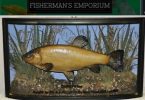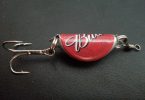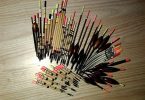The article below was written by Steve Randles on the Anglers’ Net Photography Forum. As it seems to have a broader appeal, we’ve ‘lifted’ it and published it in the main area of the site.
If you would like to read similar articles, or discuss this one, please click here.
Elton Murphy – Editor
We seem to have a diverse mixture of photographers and equipment on Anglers’ Net with varying skill levels, and when I say skill I mean experience using the camera. There is a confusing array of details or settings on most cameras and unless you understand the principles of what your actually trying to achieve, it can be very disheartening, I know this because I have been there and remember it well. This is written primarily for dslr camera owners although I hope that members with point and shoot cameras will be able to benefit from some of the following.
Here I will attempt to in simplistic terms educate, with the final result being that you, the reader will be able to take back control from your camera’s “auto” mode and use it as the tool it was designed for, to use your creativity and take fantastic photographs. I’m an amateur photographer, please don’t forget that and I welcome any criticism, discussion or correction on anything that I write on the subject. The following is a collection of information from various articles, books, magazines, forums and pestering other photographers whilst out and about, and my own conclusions and realisations on the subject. This is how I see it, and why I now use manual only on my camera.
What is Photography?
Photography: Greek “drawing with light” from photos = light, and graphis = stylus, paintbrush or graphê = representation by means of lines, drawing.
Photography is the technique of recording, by chemical or mechanical means, a permanent image on a layer of material sensitive to light exposure. However, we need the artistic or creative side to have the perfect photo. Photography is a way to bring your imagination, your concept, your ideas, your composition of the way you see the world to life on film. We all see the world differently therefore all of us produce unique and different photographs. Photography is a broad subject that eventually boils down to a mixture of art and science. So now let’s get started, learning the fundamentals and basics of the technical end to then use that to learn and explore the creative end.
Shutter and Aperture Control
If you have not read your camera manual (why not?), Please read and familiarize yourself with your camera control positions. Where shutter speed, aperture controls and ISO are located and how you control them.
Aperture (F-stop): – controls the amount of light entering the camera. Controlled by the Lens.
f-1, f-1.4, f-2.8, f-3.5, f-4
large opening (large amount of light)
f-5.6, f-6.7, f-7, f-8, f-9
medium opening (less light)
f-11, f-16, f-22, f-32
small opening (small amount of light)
The aperture is like the pupil of an your eye, allowing light to reach the film or sensor, the smaller the number on the aperture scale the more light that is allowed in due to the opening is larger. The larger the numbers on the aperture scale the less light that is allowed in due to the opening is smaller.
Shutter Speed : controls the length of time the film is exposed for. Controlled by the Camera.
1/4000, 1/2000, 1/1000, 1/750,
Fast – Less light
1/500, 1/250, 1/180, 1/125,
slowing – increasing light
1/90, 1/60 – below 1/60 you will need a tripod/monopod.
slow – more light
In combination with the variation of the lens aperture, the SS regulates how exposed the film will be. The scope or range of the speed of the shutter follows a standard sequence with each one being half that of the previous, allowing half as much light to pass through. To know where what settings to use you must be able to read the light, to read the light, you need a light meter. You should have one in your camera.
Using a Lightmeter is a fairly straightforward operation. The meter will take a ‘reading’ from the scene. You will then be presented with information about the necessary aperture or shutter settings that may be required. These readings are based on the amount of light reflected back from the scene and on the sensitivity of the film you are using (ISO setting). You must inform the meter of the correct film speed either by setting it manually or using DX coded film (the auto camera will read the film), for digital you must set the ISO.
Depending on your camera there are different types of lightmeters used in cameras.
Match needle – An illuminated scale from plus to minus – you need to get the needle to the centre.
Plus or Minus – An illuminated plus sign (over exposure), minus sign (under exposure) or a zero (OK) symbol to the side of the focusing screen.
F-stop meter – A range of shutter speeds with a symbol indicating the currently set shutter speed and an LED’s (little red lights). Steady LED for set speed and flashing LED for recommended speed.
Auto meter – In manual mode you have control of both shutter and aperture and can adjust either or both to reach the correct exposure. You are aiming to ‘zero’ on a plus minus system.
Depth of Field
Basically for a background and or foreground to be out of focus you want an aperture that is a large opening. For a background and or foreground that is out of focus, but multiple subjects are in focus you want an aperture that is a medium opening. For a background and or foreground in focus with the subjects you want an aperture that is a small opening.
Remember you always want your subject to be in focus!
DOF is Narrow
When Aperture/F-stops
are set to
f1, f1.4, f2.8, f3.5, f4
and Focal Length is Broad
Objects behind and in front of subject are out of focus. Your DOF is narrow because the light is not focused across the planes of field. Focal Length is broad across all the planes that the objects are on.
DOF is Medium
When Aperture/F-stops
are set to
f5.6, f6.7, f8, f9
and Focal Length is Medium
Objects behind and in front of subject are still out of focus. But starting to come into focus closer to the subject, Focal Length is starting to bring the planes closer together to achieve this.
DOF is Broad
When Aperture/F-stops
are set to
f11, f16, f22, f32
and Focal Length is Narrow
Objects behind and in front of subject are in focus. Now your DOF is broad because the light is focused across all the planes of field. Focal Length is narrow, meaning all planes have been Brought together into one plane.
ISO settings (Film grade)
ISO settings will affect how the lightmeter reads the scene and light in front of the camera. So where do you set your ISO, or what type of film do you purchase?
“A film speed number tells how sensitive that film is to light. There are several rating systems for film speed. The most common in English-speaking countries are ISO (International Organization for Standardization) and EI (exposure index). ASA (American Standards Association) is an older rating system that is still sometimes mentioned. All use the same numerical progression, the film speed rating doubles each time the light sensitivity of the film doubles.
The higher the number in a given system, the faster the film, and the less light needed for a correct exposure. An ISO – or EI or ASA – 200 film is twice as fast as an ISO 100 film (one stop faster), half as fast as an ISO 400 film (one stop slower). For correct exposure, the ISO 200 film needs half as much light as (one stop less than) the ISO 100 film, twice as much light as (one stop more than) the ISO 400 film.
Film speed – Light needed
ISO 100 – ****
ISO 200 – **
ISO 400 – *
Sometime the ISO rating includes the European DIN (Deutsche Industrie Norm) rating, for example, ISO 200/24 deg. The DIN rating adds 3 each time the film speed doubles. DIN 24 (equivalent to ISO 200) is twice as fast as DIN 21, half as fast as DIN 27. Except for the unlikely case of using a piece of equipment marked only with DIN number, you can ignore the DIN part of an ISO rating.
Some typical film speeds and their uses are:
Slow: ISO 50 or less – Brightly lit subjects. Finest grain.
Medium-speed: About ISO 100 – General outdoor use. Medium-fine grain.
Fast: About ISO 400 – Indoor or dimly lit scenes, bright scenes With fast moving subjects. Medium grain.
Extra fast: More than ISO 400 – Very dark scenes, especially with moving
Subjects. Coarsest grain.â€
Putting it all together – Taking photographs using full manual control
1) Find your scene, what are you shooting (ISO setting comes into play here) set your ISO.
2) Set you aperture first…set up composition, where do you want your DOF…you are setting for background and foreground focus.
4) Read the scene with the lightmeter, set your shutter speed accordingly for correct exposure.
5) Expose the scene.
Hey presto, job done and a good photo is on your card!
Now, a couple of quick tests for you.
Portrait shot
With the help of a family member, friend or partner, have them stand or sit in an open space in your garden (must be outside and don’t use your flash). By open space I mean without a bush or fence behind for four or five feet. Now switch your camera to manual mode and set your ISO to suit the light of the day. You are going to blur the background which is quite typical of portrait shots, defining the portrait even more. So with ISO set you now need to set the aperture for a narrow depth of field. Next, compose your shot..get close enough to your subject so he/she fills the viewfinder, either head and shoulders, from the waist up or somewhere in between. Now using your cameras built in lightmeter set your shutter speed for a correct exposure, take a breath, hold it and gently squeeze the shutter release.
Landscape shot
This time you’ll need a broad depth of field, so around f11, choose a scene either a rolling countryside shot if you can or a view down a local street, in short any shot where there will be objects over a good range of distance so that when you view the final photo on your pc, you can see what depth of field you achieved.
So again, set your ISO then aperture, then using your lightmeter set your shutter speed for correct exposure and take the shot.
I hope some of you find this useful and if I have made any mistakes, I am corrected
Steve Randles
If you would like to read similar articles, or discuss this one, please click here.







